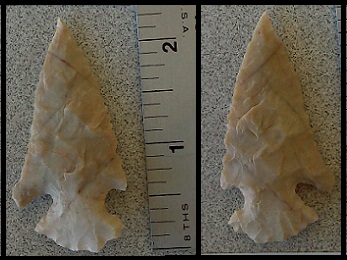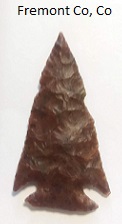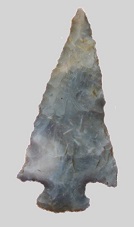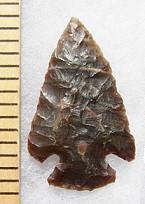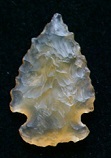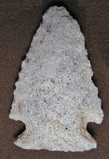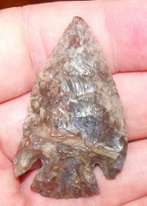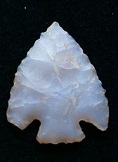Outline is Representative of Size and Shape:
 Cienega (Tularosa Basal Notch)
Cienega (Tularosa Basal Notch)
 Cienega (Tularosa Corner Notch)
Cienega (Tularosa Corner Notch)
 Cienega (Tularosa Basal Notch)
Cienega (Tularosa Basal Notch) Name Details:
Identified By: Bruce B. Huckell and Emil W. Haury
Named For: Cienega Valley, Southern Santa Cruz drainage, Arizona
Date Identified: 1988
Type Site: Two Late Archaic sites in Cienega Valley
Identified By: Bruce B. Huckell and Emil W. Haury
Named For: Cienega Valley, Southern Santa Cruz drainage, Arizona
Date Identified: 1988
Type Site: Two Late Archaic sites in Cienega Valley
Point Validity:
Valid type
Huckell is an anthropologist and has served as the Director of the Museum of Anthropology and a Professor at the University of New Mexico. Haury is a distinguished anthropologist and is famous for his work at Snaketown (a Hohokam site) in Arizona. This type was named in a professional publication and has many professional references. This is considered a valid type.
Huckell is an anthropologist and has served as the Director of the Museum of Anthropology and a Professor at the University of New Mexico. Haury is a distinguished anthropologist and is famous for his work at Snaketown (a Hohokam site) in Arizona. This type was named in a professional publication and has many professional references. This is considered a valid type.
Cienega Corner / Basal Notch
AKA: Tularosa Corner NotchTularosa Basal Notch
Cluster: Cienega Cluster
Description of Physical Characteristics and Flaking Pattern:
This is a small to medium triangular point with an elliptical cross section. The blade may vary from excurvate to straight. Notches may enter the blade from the corners of the preform to the base of the preform. The notch placement create shoulders that may vary from slightly barbed to strongly barbed. Examples where the notch enters the blade slightly above the corner may have an almost horizontal shoulder. The stem is expanding. The stem ranges from straight to convex. This point does not have any hafting grinding present. This point has a random flaking pattern.
Size Measurements:
Total Length - 22 to 75 mm, Stem Length - 9 to 13 mm, Blade Width - 19 to 36 mm, Neck Width - 9 to 16 mm, Stem Width - 13 to 21 mm
Total Length - 22 to 75 mm, Stem Length - 9 to 13 mm, Blade Width - 19 to 36 mm, Neck Width - 9 to 16 mm, Stem Width - 13 to 21 mm
Commonly Utilized Material:
Additional Comments:
These points were originally defined by Huckell and Haury in 1988. This type was sub-divided into the Tularosa Corner Notch, Tularosa Basal Notch, and the Guadalupe point by Justice in 2002. This point is thought to have evolved from the San Pedro type (Justice, 2002).
These points were originally defined by Huckell and Haury in 1988. This type was sub-divided into the Tularosa Corner Notch, Tularosa Basal Notch, and the Guadalupe point by Justice in 2002. This point is thought to have evolved from the San Pedro type (Justice, 2002).
Distribution: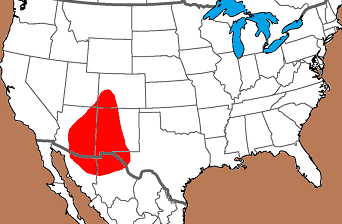

Distribution Comments:
This point is primarily found at Mogollon sites and trading regions of eastern Arizona and western New Mexico. This point has been reported into southwestern Colorado. Distribution extends into northern Chihuahua and northeastern Sonora Mexico.
This point is primarily found at Mogollon sites and trading regions of eastern Arizona and western New Mexico. This point has been reported into southwestern Colorado. Distribution extends into northern Chihuahua and northeastern Sonora Mexico.
Age / Periods:
Date: 2,100 - 1,300 B.P.
Cultural Period:Transitional Archaic to Developmental
Glacial Period: Roman Warm
Culture: Mogollon Culture
Date: 2,100 - 1,300 B.P.
Cultural Period:Transitional Archaic to Developmental
Glacial Period: Roman Warm
Culture: Mogollon Culture
Age Details:
This type is part of the early Cienega Phase.
This type is part of the early Cienega Phase.
Similar Points:
Armargosa, Black Mesa, Carlsbad, Dolores, Durango, Elko Corner Notch, En Medio, Patinadas, San Pedro
Armargosa, Black Mesa, Carlsbad, Dolores, Durango, Elko Corner Notch, En Medio, Patinadas, San Pedro

